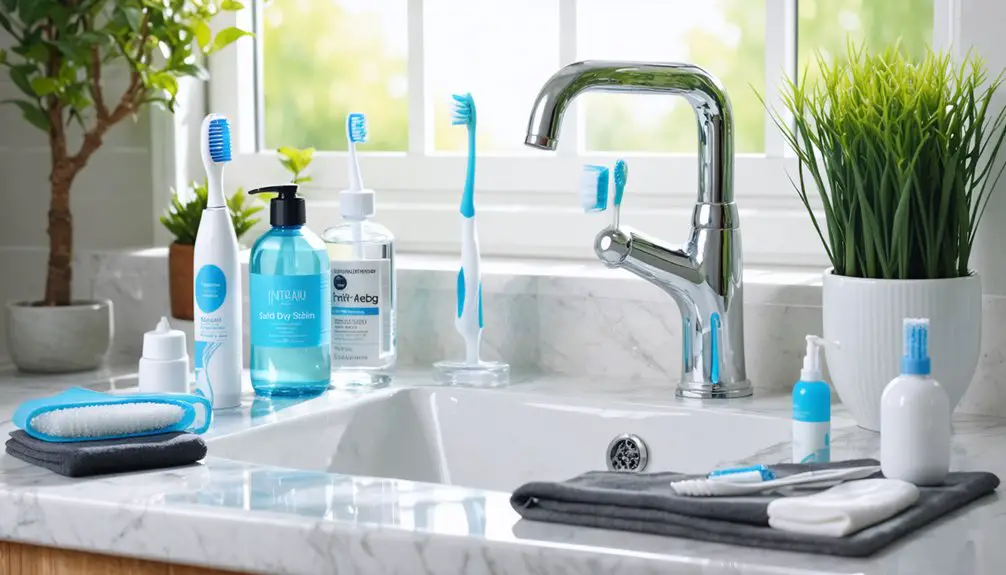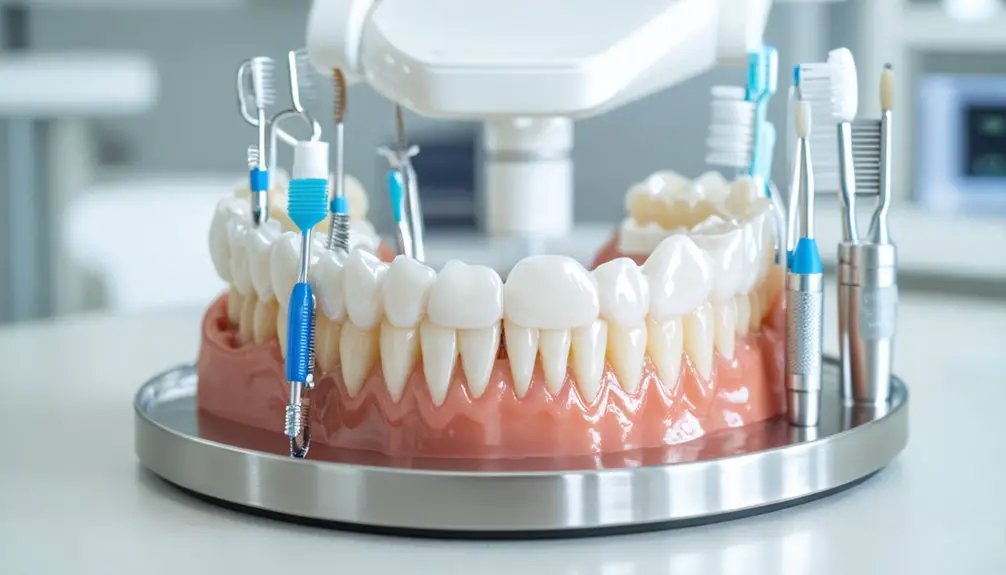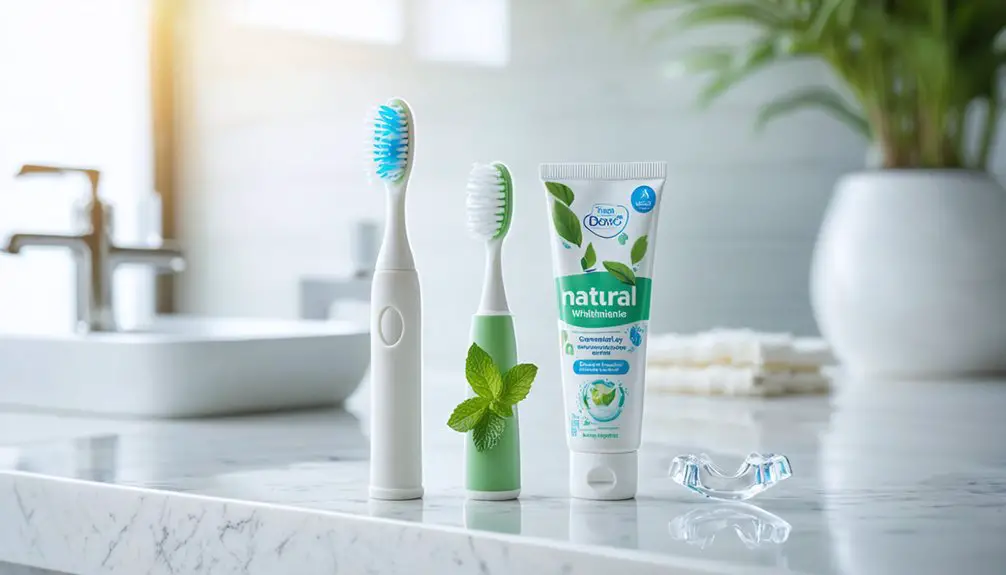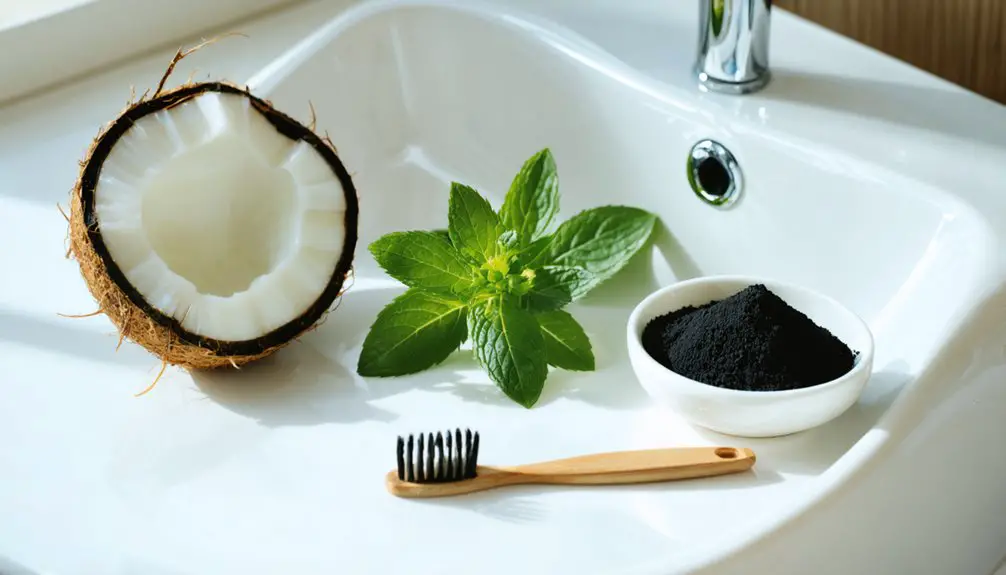To avoid tooth infection risks during whitening, you’ll need to choose a licensed dental professional who follows strict sterilization protocols. Maintain excellent oral hygiene before treatment, including professional cleaning to remove plaque and tartar. Use ADA-approved products, follow application instructions precisely, and monitor for warning signs like persistent pain or swelling. Keep your equipment sterile, practice thorough post-treatment care, and schedule regular check-ups. Understanding additional preventive measures can further protect your oral health during the whitening process.
Key Takeaways
- Choose a licensed dental professional who follows strict sterilization protocols and maintains ADA-approved safety standards during whitening procedures.
- Schedule a professional dental cleaning before treatment to remove plaque, tartar, and potential infection-causing bacteria.
- Maintain rigorous oral hygiene with twice-daily brushing and daily flossing before, during, and after whitening treatments.
- Monitor for warning signs like persistent pain, swollen gums, or fever, and stop treatment immediately if complications arise.
- Use only ADA-approved whitening products with appropriate peroxide concentrations and follow application instructions precisely.
Choose a Licensed Dental Professional for Whitening
While teeth whitening may seem like a simple cosmetic procedure, choosing a licensed dental professional is crucial for both safety and ideal results.
You’ll want to verify your provider’s credentials through state dental board websites, looking specifically for DDS or DMD qualifications that confirm their authority to perform whitening treatments.
Licensed professionals follow strict dental regulations and safety protocols that protect you from infection risks and chemical burns.
They’ll conduct thorough pre-treatment assessments to check for contraindications like enamel erosion or existing restorations.
Your dentist will monitor the entire process, adjusting bleaching agent concentrations to match your specific needs while maintaining sterile conditions.
This professional oversight guarantees you’ll receive treatment that’s not only effective but also compliant with ADA guidelines for safe teeth whitening.
Professional whitening treatments can achieve up to eight shades of teeth brightening with proper supervision.
The in-office blue whitening treatment is considered the safest and most effective method available for professional teeth whitening.
Maintain Proper Oral Hygiene Before Treatment
You’ll need to brush at least twice daily and floss once daily to remove harmful plaque and debris that can compromise your whitening treatment’s effectiveness.
A thorough professional dental cleaning before whitening will eliminate stubborn tartar buildup and surface stains while creating ideal conditions for the whitening agents to work. These cleanings are essential since hydrogen peroxide treatments work best on professionally cleaned teeth.
Your commitment to consistent oral hygiene in the weeks leading up to treatment will greatly reduce your risk of infection and enhance your whitening results. Using an antiseptic mouthwash after brushing helps eliminate bacteria and prevents bad breath before your whitening procedure.
Daily Brushing and Flossing
Before beginning any teeth whitening treatment, establishing proper oral hygiene habits is crucial for peak results and minimizing infection risks.
You’ll need to brush twice daily with fluoride toothpaste, guaranteeing thorough cleaning of all tooth surfaces to reduce bacteria buildup. Proper flossing techniques include using a clean section of floss for each tooth space and gently moving it up and down against the tooth surface.
Follow your brushing benefits by incorporating an antiseptic mouthwash into your routine to further reduce bacterial presence. Healthy gums are essential for successful whitening treatments and reducing complications.
Having an oral health professional conduct an exam before starting whitening is vital to identify any potential issues that could affect the treatment.
You’ll notice improved whitening effectiveness when your teeth are free from plaque and food particles. Regular dental check-ups will help monitor your hygiene index and guarantee you’re maintaining ideal oral health.
This all-encompassing approach greatly reduces your risk of infection during whitening procedures while maximizing treatment outcomes.
Removing Plaque and Debris
Since effective plaque removal directly impacts whitening success, maintaining meticulous oral hygiene in the weeks leading up to treatment is essential.
You’ll need to implement thorough plaque removal techniques, including interdental brushes and water flossers, to reach areas where regular floss might miss debris. Schedule a professional cleaning to eliminate stubborn tartar buildup that home care can’t address.
For best debris management strategies, use non-alcoholic antibacterial mouthwash to reduce bacterial load and balance oral pH. Brush twice daily and use proper brushing technique to maximize plaque removal before your whitening procedure. Using fluoride toothpaste helps strengthen teeth while cleaning them thoroughly.
You’ll want to avoid staining foods and acidic beverages 48 hours before treatment, as they can compromise enamel integrity. Clean your tongue regularly to decrease overall bacterial presence, and maintain proper hydration to help flush away loose particles.
These preventive steps will create ideal conditions for your whitening procedure.
Deep Clean Before Whitening
A thorough deep clean stands as the foundation for safe and effective tooth whitening treatment. One of the key deep cleaning benefits is the removal of stubborn plaque and tartar that regular brushing can’t eliminate, creating an ideal surface for whitening agents to work uniformly. Regular dental visits help maintain optimal oral health between treatments.
Among essential whitening preparation tips, you’ll need to schedule a professional cleaning before your treatment. This step helps identify potential oral health issues and reduces bacteria that could lead to post-whitening complications.
Your dental professional will remove built-up deposits, ensuring the whitening gel can contact your enamel evenly. You’ll also want to maintain consistent brushing with sensitive toothpaste, daily flossing, and gentle antibacterial mouthwash use. Custom whitening trays ensure the most effective application of whitening gel while protecting your gums from irritation.
This all-encompassing approach minimizes infection risks while maximizing your whitening results.
Understand Product Safety and Regulations
When selecting teeth whitening products, you’ll need to understand the complex regulatory frameworks that govern their safety and use.
Start by carefully reviewing product labels, which must include detailed safety information and directions in appropriate languages. Pay special attention to ingredient disclosure, particularly the concentration of peroxides, as levels above 6% aren’t safe for home use.
Look for products that carry the ADA Seal of Acceptance, as these have undergone voluntary safety and effectiveness reviews.
Be aware that different countries classify whitening products differently – they’re considered cosmetics in the EU but may be classified as drugs or Class I medical devices in the US.
If you’re serving clients, make certain you’re following your region’s specific regulations regarding professional application and supervision requirements.
Follow Application Instructions Carefully
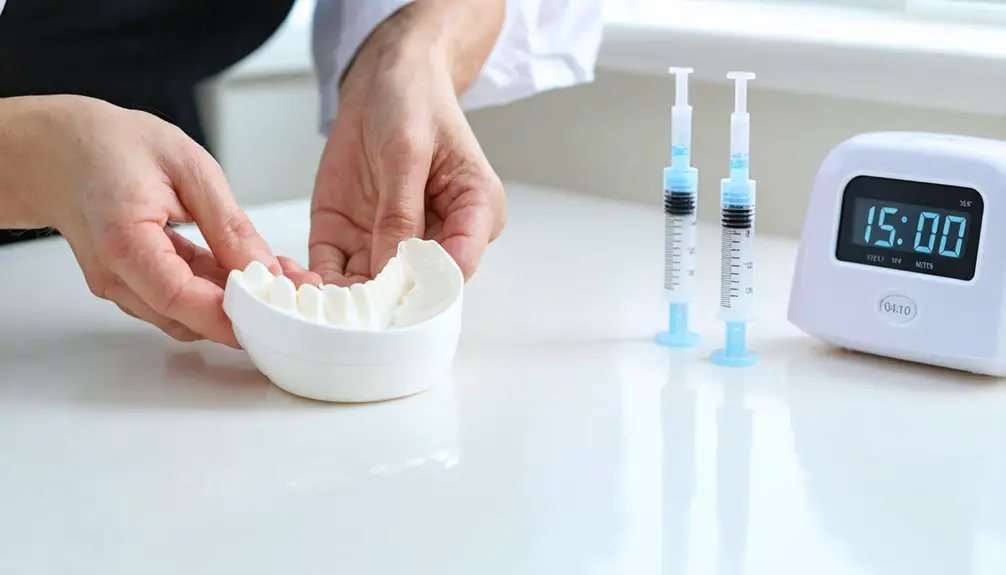
To minimize infection risks during teeth whitening, proper application technique serves as your primary defense against complications.
Start by brushing and flossing thoroughly before each session, ensuring your trays are clean and completely dry. Apply a small drop of gel per tooth, using only 1/4 to 1/5 cc total per tray to prevent gum exposure.
For optimal results and safety, prepare teeth thoroughly and apply minimal gel amounts, keeping trays clean and dry throughout treatment.
Monitor application timing carefully, following product-specific guidelines that typically range from 5 minutes to 1 hour. Don’t exceed recommended durations, particularly with stronger concentrations like 35% carbamide peroxide gels.
Maintain gel consistency by storing trays in a cool, dry place and cleaning them after each use. If you experience sensitivity or irritation, reduce treatment frequency or pause your regimen.
Remove any gel that contacts your gums immediately to prevent tissue damage and potential infection.
Use Sterile Equipment and Tools
Maintaining sterile equipment and tools plays an essential role in preventing infections during teeth whitening procedures. When you’re performing whitening treatments, proper sterilization protocols and instrument handling are critical for patient safety.
You’ll need to guarantee all reusable equipment undergoes thorough cleaning with enzymatic detergents followed by steam sterilization at 250-273°F.
- Clean instruments immediately after use or soak them in detergent solution to prevent biological material from drying.
- Package sterilized instruments in FDA-approved wraps and store them in a clean, dry environment until needed.
- Replace disposable items like gloves, masks, and barriers between each patient to eliminate cross-contamination risks.
Remember to document your sterilization processes and regularly monitor equipment performance using biological or chemical indicators to verify effectiveness.
Monitor for Warning Signs During Treatment
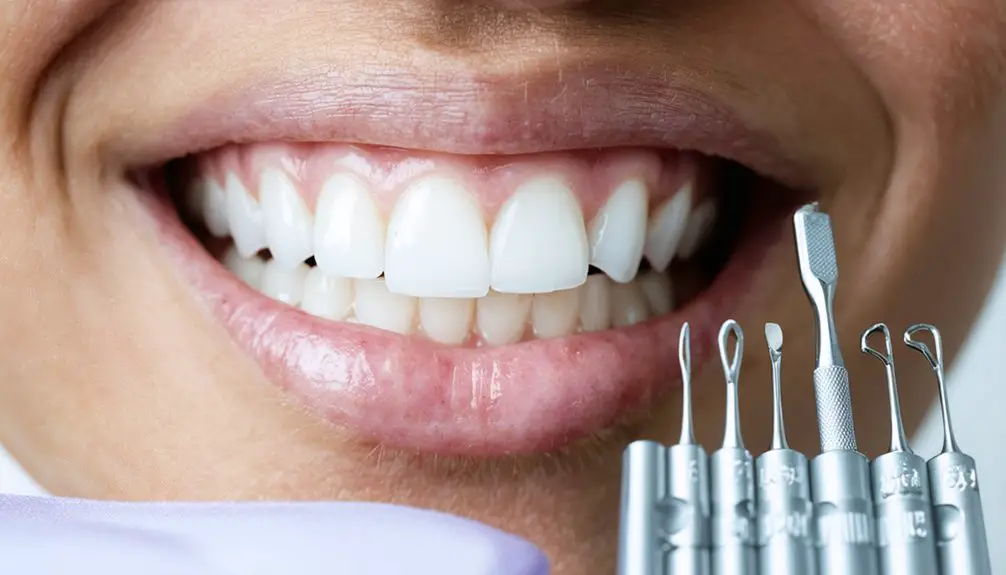
Recognizing warning signs during teeth whitening treatment can help prevent serious complications and infections from developing. You’ll need to watch for specific whitening symptoms that indicate potential issues. Pay attention to persistent pain that spreads beyond treated teeth, expanding redness in gums, or swollen lymph nodes under your jaw.
As part of your treatment precautions, monitor for burning sensations or inflammation where the bleaching agent contacts your gums. If you experience difficulty swallowing, breathing problems, or develop a fever above 100°F with chills, stop treatment immediately and seek professional help.
Watch for signs of increased tooth sensitivity, especially to temperature changes, and note any bleeding or tenderness while brushing. Don’t ignore mild symptoms, as they can quickly escalate to severe infections requiring medical intervention.
Practice Post-Treatment Care and Hygiene
Proper post-treatment care plays an essential role in preventing infections and maintaining your whitening results. Your post-treatment habits should focus on protecting sensitive enamel while preventing stains and bacterial growth.
Post-whitening care is crucial for preventing complications and preserving your bright smile through proper enamel protection and stain prevention.
For ideal sensitivity management, use desensitizing toothpaste and avoid acidic foods for at least 48 hours. Maintain rigorous oral hygiene with gentle brushing techniques and daily flossing to minimize infection risks.
- Rinse frequently with water during the first 48 hours instead of using colored mouthwash
- Wait 30 minutes after consuming acidic foods before brushing to protect vulnerable enamel
- Use only soft-bristled toothbrushes and non-abrasive whitening products for maintenance
Remember to stay hydrated and avoid staining foods and beverages for the first two days to guarantee the best possible outcome from your whitening treatment.
Recognize When to Stop Treatment
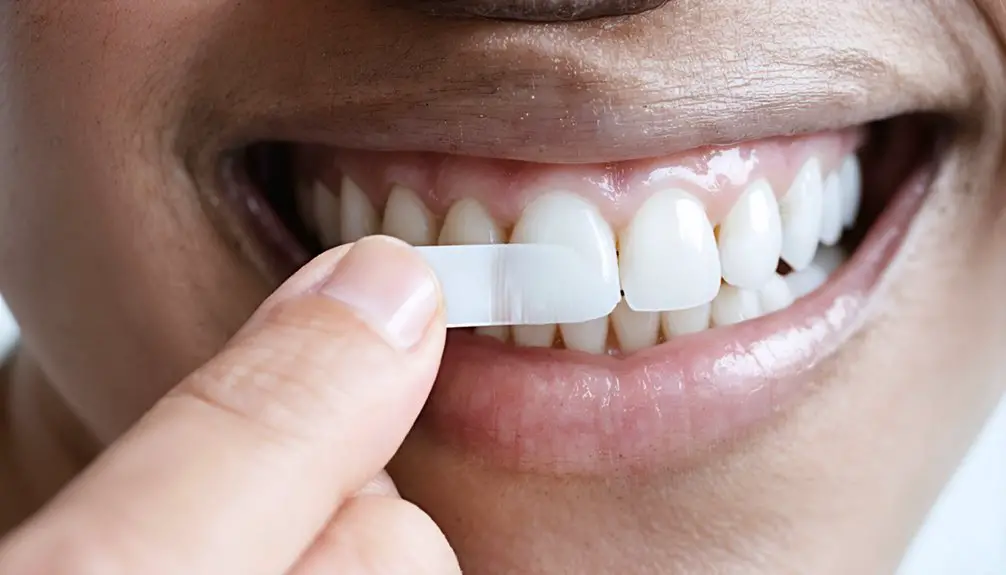
While tooth whitening can effectively enhance your smile, knowing when to stop treatment is essential for preventing permanent damage to your oral health.
Monitor your teeth for sensitivity signs like persistent reactions to hot, cold, or sweet substances that last beyond several days. You’ll need to halt treatment if you notice gum irritation, including redness, swelling, or burning sensations that don’t resolve quickly.
Watch for concerning developments such as uneven coloration, enamel roughness, or visible texture changes. Stop immediately if you experience allergic reactions like oral blisters or systemic symptoms.
Additionally, if you’ve reached a whitening plateau where no further improvements occur after multiple sessions, continuing treatment only increases your risk without additional benefits.
Schedule Regular Dental Check-ups
You’ll need consistent check-ups every six months to track your whitening treatment’s progress and identify potential complications before they escalate.
Your dentist can screen for hidden issues like developing infections, gum disease, or enamel damage that could interfere with safe whitening procedures.
Through professional monitoring, you’re able to maintain peak oral health while achieving your desired whitening results safely and effectively.
Monitor Dental Health Progress
Regular dental check-ups serve as a cornerstone in preventing tooth whitening infections and maintaining ideal oral health. Your dentist will track changes in your oral health assessment through detailed documentation, helping identify potential infection risks before they become serious issues.
By monitoring your progress consistently, you’ll receive personalized recommendations based on your specific risk factors and oral health status.
- Documentation from each visit allows your dentist to spot concerning patterns and adjust treatment plans accordingly.
- Risk-based monitoring intervals guarantee you’re getting the right level of care for your specific needs.
- Regular evaluations of lifestyle factors and systemic health conditions help determine your infection risk level.
This systematic approach to tracking your dental health enables early intervention and prevents complications that could interfere with tooth whitening procedures.
Screen For Hidden Issues
Before undergoing any tooth whitening treatment, scheduling thorough dental check-ups enables professionals to screen for hidden issues that could compromise your results or oral health.
During these examinations, your dentist can detect hidden cavities, enamel erosion, or gum inflammation that might worsen with bleaching agents. They’ll also identify discoloration causes that won’t respond to whitening, such as gray stains from trauma or medication.
Your dental team will evaluate existing restorations since whitening won’t affect them, potentially requiring updates to match your desired shade.
They’ll assess your enamel and dentin health to minimize sensitivity risks and protect compromised gingival tissue.
This thorough screening process helps create a customized whitening protocol that safeguards your oral health while achieving ideal results.
Document Your Whitening Process
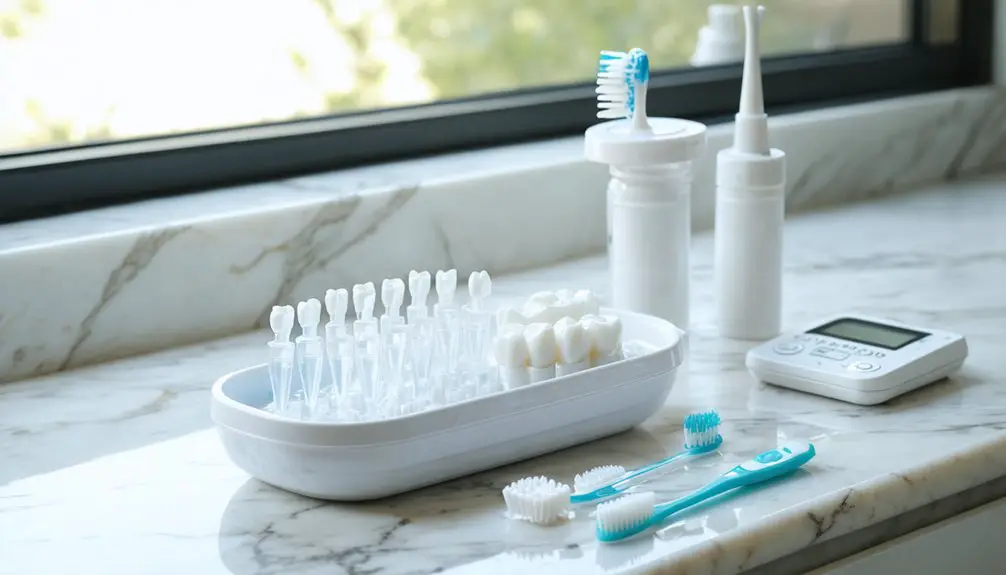
To minimize infection risks and guarantee ideal results, maintaining meticulous documentation throughout your tooth whitening process is essential. Your whitening protocols should include detailed records of baseline tooth shades, treatment sessions, and any modifications made based on patient sensitivity.
Proper patient documentation helps you track progress, verify safety compliance, and provide evidence-based care.
- Take standardized photographs under consistent lighting conditions, using intraoral retractors and contrast tools to capture accurate tooth shades.
- Record specific whitening agents used, including concentration levels and application times for each treatment session.
- Document all follow-up appointments, patient-reported symptoms, and any interventions needed to address sensitivity or complications.
These records protect both you and your patients while enabling precise monitoring of treatment effectiveness and early detection of potential issues.
Frequently Asked Questions
Can I Whiten My Teeth While Wearing Braces or Other Orthodontic Appliances?
Look before you leap – braces impact your whitening options considerably. You’ll get safer, more uniform results by waiting until after treatment, though you can use whitening toothpaste and mouthwash during orthodontics.
How Long Should I Wait Between Whitening Treatments to Prevent Infection?
You’ll need to wait 6-12 months between professional whitening treatments and 2-4 weeks between at-home applications. Following these treatment intervals protects your enamel and prevents infection-causing damage.
Does Tooth Whitening Affect Existing Dental Implants or Root Canals?
You can’t whiten dental implants or root canals since they’re artificial materials. While whitening is safe, it’ll only affect your natural teeth, potentially creating color mismatches that require professional attention.
Can Certain Medications Increase Infection Risks During Teeth Whitening Treatments?
Yes, your medications’ side effects can increase whitening-related infection risks through dry mouth, weakened immunity, gum changes, and enamel erosion. Always discuss your medications with your dentist before starting whitening treatment.
Are Natural Whitening Methods Like Charcoal or Lemon Juice Safer?
No, natural methods aren’t safer. Charcoal safety concerns include enamel erosion and increased bacteria buildup, while lemon juice effects are highly destructive due to acid that permanently damages your teeth.
References
- https://www.nature.com/articles/s41415-019-0188-8
- https://www.jeffreydmontgomerydds.com/the-risks-of-teeth-whitening-expert-advice-from-a-gate-city-dentist/
- https://adanews.ada.org/huddles/hazards-of-unlicensed-tooth-whitening/
- https://ec.europa.eu/health/scientific_committees/opinions_layman/en/tooth-whiteners/l-2/2-tooth-whitening-health-effects.htm
- https://pmc.ncbi.nlm.nih.gov/articles/PMC6784469/
- https://www.ashbydentalgroup.com/is-teeth-whitening-safe
- https://www.soladentalspa.com/blog/is-teeth-whitening-done-by-a-cosmetic-dentist-safe
- https://www.aapd.org/globalassets/media/publications/archives/lee-27-5.pdf
- https://www.thedentalspajersey.com/blog/teeth-whitening-statistics-2024
- https://pmc.ncbi.nlm.nih.gov/articles/PMC4058574/
